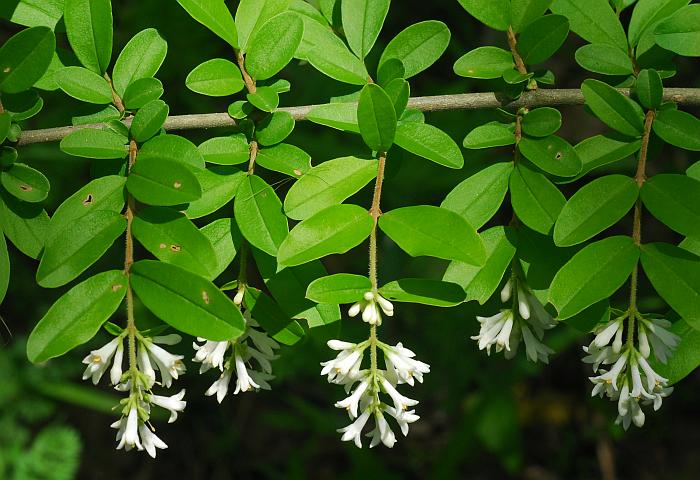Ligustrum obtusifolium Siebold & Zucc.
Border Privet

Introduced
CC = *
CW = 5
MOC = 17
© SRTurner
Ligustrum obtusifolium Siebold & Zucc.Border Privet | |
 |
Introduced CC = * CW = 5 MOC = 17 |
© SRTurner |
|
Family - Oleaceae Habit - Shrub to 2 m tall. Stem - Main stems numerous, arched, with spreading branches. Twigs moderately to densely pubescent with minute, spreading hairs, the new growth grayish green, becoming dark gray with lighter colored lenticels. Winter buds with the scales tawny, short-hairy.
Leaves - Opposite, sometimes subopposite, simple, short-petiolate. Petioles 1-3 mm long, glabrous or short-hairy, narrowly winged. Leaf blades 2-6 cm long, 7-25 mm wide, relatively thin and herbaceous, elliptic to oblong-ovate, rounded to bluntly or broadly angled at the tip, the upper surface glabrous, not shiny, the undersurface short-hairy, at least along the midvein, minutely but faintly gland-dotted.
Inflorescences - Panicles or racemes at branch tips, spreading to nodding, relatively slender, 1.5-4.0 cm long.
Flowers - Calyces with 4 very shallow, irregular lobes, moderately to densely short-hairy. Corollas 6-10 mm long, 4-lobed, trumpet-shaped, the tube slightly longer than to about 3 times as long as the lobes, white. Stamens not exserted. Style 1-2 mm long.
Fruits - Berrylike drupes, 5-8 mm long, globose to broadly ellipsoid, green to olive green, turning bluish black or black, glabrous, sometimes slightly glaucous. Flowering - May - June. Habitat - Forests, glades, stream banks, old fields, ditches, roadsides, disturbed areas. Origin - Native to Asia Lookalikes - Other species of Ligustrum. Other info. - Border privet was first reported from Missouri in 1991. It has been spreading rapidly since then and is now understood to be an invasive species in our region. At Shaw Nature Reserve, for example, it has become a problem rivaling bush honeysuckle in severity. A number of different privets have been cultivated in Missouri to serve as hedgerows, and these species can be difficult to differentiate. All privets are introduced in our area, and it would be wise to avoid their use until their growth habits are better understood. Photographs taken at Shaw Nature Reserve, Franklin County, MO, 5-21-2015 (SRTurner). |